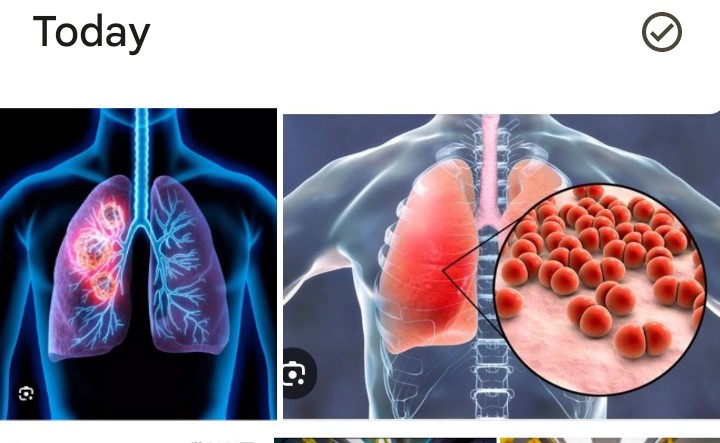By Husaini Legbo Husaini

What you should know about pneumonia
Symptoms
Types
Walking pneumonia
Treatment
In children
Causes
Risk factors
Complications
Prevention
Diagnosis
Summary
Pneumonia is an inflammation of one or both lungs, typically due to a bacterial, viral, or fungal infection. With pneumonia, the tiny air sacs inside the lungs fill with fluid or pus, leading to coughing, chest pain, and breathing difficulties.
Anyone can develop pneumonia. The people most at risk of developing pneumonia are young children, older adults, and people with preexisting medical conditions that weaken the immune system. These same groups of people are also at increased risk of developing complications of pneumonia.
This article outlines the symptoms of pneumonia in adults and children and its causes, diagnosis, and treatment. We also provide information on pneumonia risk factors, complications, and prevention.
Fast facts on pneumonia
Pneumonia is an infection of the lungs that can cause mild to severe illness in people of all ages.
It is the leading cause of death due to infection in children younger than 5 years of age worldwide.
Pneumonia and influenza together are ranked as the eighth leading cause of death in the United States.
Those at high risk of pneumonia include older adults, the very young, and people with underlying health problems.
Symptoms
Daniel Allan/Getty Images
The first symptoms of pneumonia usually resemble those of a cold or flu. A person may then develop other symptoms, which can vary depending on the type of pneumonia a person has.
Common symptoms include:
cough that may produce green, yellow, or even bloody phlegm
fast breathing and shortness of breath
chest pain that usually worsens when taking a deep breath
fast heartbeat
fever, sweating, and chills
fatigue
confusion or delirium, especially in older adults
loss of appetite
nausea and vomiting
Types
Pneumonia types differ depending on their cause. The different types and their associated causes include:
Bacterial pneumonia: Many bacterial strains can cause pneumonia, but the most common is Streptococcus pneumoniae (S. pneumoniae). A doctor may refer to pneumonia resulting from this strain as pneumococcal pneumonia.
Viral pneumonia: Viral causes of pneumonia includeTrusted Source the respiratory syncytial virus and influenza types A and B.
Fungal pneumonia: This can result fromTrusted Source a condition such as valley fever, caused by the Coccidioides fungus.
Aspiration pneumonia: This type occurs as a result of inhaling food, liquids, or stomach contents into the lungs. Aspiration pneumonia is not contagious.
Hospital-acquired pneumonia: This can occur in people receiving hospital treatment for other conditions that involve use of a respirator or breathing machine.
Regardless of the cause of pneumonia, the signs and symptoms will be similar.
Walking pneumonia
Walking pneumonia is a non-medical term that describes a mild case of pneumonia with cold-like symptoms. The condition is so-called because people with this type of pneumonia typically do not require bed rest and can continue their usual daily activities.
Despite the name, people with walking pneumonia should rest as much as possible to speed up their recovery. Resting also reduces the risk of spreading the pneumonia-causing pathogens to other people.
Most people with walking pneumonia begin to feel better within 3–5 days. They can take over-the-counter (OTC) medications to ease any symptoms during this time.
Treatment
Treatment for pneumonia depends on the type and severity of the pneumonia.
The main types and their associated treatments include:
Bacterial pneumonia: Treatment is usually with antibiotics.
Viral pneumonia: Treatment is not usually necessary, though a doctor may prescribe antiviral medications if influenza is the cause.
Fungal pneumonia: Treatment usually involves antifungal medications.
Doctors commonly prescribe OTC medications to help manage the symptoms of pneumonia. These can help with the following symptoms:
cough
fever
aches and pains
Whatever the cause of pneumonia, it is important that people rest and drink plenty of fluids. Staying hydrated helps thin out thick phlegm and mucus, making it easier to cough up.
Hospitalization
Hospitalization for pneumonia may be necessary if symptoms are severe or a person has a weakened immune system or other serious illness.
In the hospital, people may receive intravenous antibiotics and fluids. They may also need a supplemental oxygen supply.
In children
In most cases, a child’s immune system will protect them from developing pneumonia. If a child does develop pneumonia, it is usually due to a virus.
Symptoms in children may include:
difficulty breathing or breathing loudly
not feeding as they usually do
coughing
fever
irritability
dehydration
Toddlers may complain of pain in their chest or stomach and vomit after coughing.
Treatment includes plenty of rest and a regular fluid intake. A doctor may suggest OTC medications to help ease symptoms such as abdominal problems or coughing, but these medicines will not help treat pneumonia.
Adults should not smoke around children, especially if the child has pneumonia.
Causes
Pneumonia is typically due to infectious pathogens, such as bacteria and viruses. These pathogens can spread via coughing and sneezing or by contaminating surfaces that people touch.
In most cases, a person contracts pneumonia-causing pathogens by breathing them into the small air sacs, or alveoli, within their lungs. The immune system responds by sending white blood cells to attack the infection, which triggers inflammation of the alveoli. The alveoli fill with fluid and pus, causing pneumonia.
Risk factors
People most at riskTrusted Source of developing pneumonia are those who:
are under 5 years old or over 65 years old
have recently recovered from a cold or influenza infection
have underlying conditions, such as:
cystic fibrosis
chronic obstructive pulmonary disease (COPD)
asthma
conditions that affect the kidneys, heart, or liver
have a weakened or impaired immune system, which may occur as a result of several conditions, including:
diabetes
HIV
AIDS
cancer
take medicines forTrusted Source gastroesophageal reflux disease (GERD)
experience malnutrition
smoke tobacco, consume large amounts of alcohol, or both
have been exposed to certain chemicals or pollutants
have been recently hospitalized in an intensive care unit
Complications
Pneumonia can cause complications.
These are more common among the following groups of people:
young children
older adults
people with certain preexisting health conditions
According to the Centers for Disease Control and Prevention (CDC)Trusted Source, some potential complications of pneumococcal pneumonia include:
Empyema: An infection of the space between the membranes that surround the lungs and chest cavity.
Pericarditis: Inflammation of the sac, or pericardium, surrounding the heart.
Endobronchial obstruction: A blockage of the airway that allows air into the lungs.
Atelectasis: A complete or partial collapse of an entire lung or an area within the lung.
Lung abscess: A collection of pus in the lungs. This is a rare complication that mostly occurs in people with serious underlying medical conditions or a history of alcohol misuse.
Other possible complications of pneumonia include:
Pleurisy: Inflammation of the thin membranes between the lungs and ribcage that can lead to respiratory failure.
Septicemia: An infection in the blood that originated elsewhere in the body.
Sepsis: A life threatening immune reaction to septicemia, which can lead to tissue damage, organ failure, and death.
Prevention
There are two different vaccines to help prevent pneumococcal disease, the most common bacterial cause of pneumonia.
The vaccines protect against a wide variety of pneumococcal infections. While they may not completely protect older adults from pneumonia, they can significantly reduce the risk of pneumonia and other infections caused by S. pneumoniae, including blood and brain infections.
There are two pneumonia vaccines available. As discussed below, healthcare professionals offer them to different ageTrusted Source groups:
Pneumococcal conjugate vaccine
The pneumococcal conjugate vaccine is a pneumococcal vaccine that doctors may refer to as Prevnar or PCV13. Doctors recommend PCV13 for the following groups:
children under 2 years old, as PCV13 is a typical part of an infant’s routine immunizations
those ages 2 years or above who have certain underlying medical conditions
Pneumococcal polysaccharide vaccine
The pneumococcal polysaccharide vaccine is a pneumococcal vaccine that doctors may also refer to as Pneumovax or PPSV23. Doctors recommended PPSV23 for the following groups:
people ages 2–64 years who have certain underlying medical conditions, such as:
diabetes
chronic heart, lung, or kidney disease
lack of a spleen due to surgical removal
adults ages 19–64 years who smoke cigarettes
all adults ages 65 years or above
Other preventative measures
Along with vaccinations, doctors recommend the following measures to help prevent pneumonia:
regular hand washing
covering the mouth and nose when coughing or sneezing
refraining from smoking
eating a balanced, nutritious diet
exercising regularly
staying away from people who have pneumonia, or being extra vigilant about hygiene when around people who are unwell
Diagnosis
To diagnose pneumonia, a doctor will usually ask about a person’s symptoms and medical history and carry out a physical examination. The physical exam may include listening to the chest through a stethoscope and measuring blood oxygen levels using a pulse oximeter attached to the finger.
A doctor may suspect pneumonia if they hear the following when listening to the chest through a stethoscope:
coarse breathing
wheezing
crackling
decreased breath sounds
If doctors suspect pneumonia, they may order additional tests, including:
Chest X-rays: These can confirm a pneumonia diagnosis and show which areas of the lungs are affected.
A chest CT scan: This scan can provide more detailed images of the lungs.
White blood cell (WBC) count: A blood test that measures levels of WBCs in the blood. This helps determine how severe the infection is and whether bacteria, virus, or fungus is the likely cause.
An arterial blood gas test: A blood test that can provide a more accurate reading of the body’s oxygen and carbon dioxide levels and other factors.
Blood cultures: These may reveal whether the microorganism from the lungs has spread into the bloodstream.
Sputum analysis: Tests the sputum to determine which pathogens are responsible for the pneumonia.
Bronchoscopy: A procedure that involves passing a bronchoscope into the lungs while a person is under anesthesia. The bronchoscope is a thin, flexible tube with a light and camera attached, which enables the doctor to directly examine infected parts of the airways and lungs. A doctor may recommend this procedure when further investigation is necessary.
Summary
Pneumonia is usually due to an infection (bacterial, viral, or fungal). People can also develop pneumonia after inhaling contaminated food, water, or saliva into their lungs.
This lung condition is more common among young children, older adults, and people with preexisting medical conditions that affect their organs or weaken their immune systems. These groups also have an increased risk of serious complications of pneumonia. As such, they should take extra measures to help prevent pneumonia, which may include receiving a pneumococcal vaccine.
Whatever the cause of pneumonia, treatment includes getting lots of rest and drinking plenty of fluids.
A doctor may recommend additional treatments depending on a person’s pneumonia type, symptoms, and overall health. People should contact their doctor if their symptoms persist or worsen
source: Medical News Today









